Historical diving

These regulations that were published by the French
ministry of labour in 1992 have been reviewed in 2012
and 2019. However, the diving tables issued by COMEX
SA under the name MT-92 have not been changed in the
last revisions and are still among the best decompression
models.
This digital document was edited by INPP (Institut
National de Plongee Professionelle) in 1998.

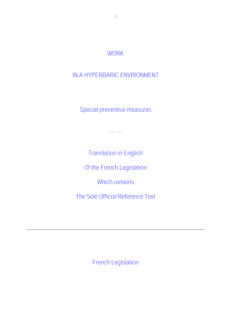

This document was published on the 20th of January
1999.
Note that this revision was the 1st publishing of the US
navy saturation procedures.

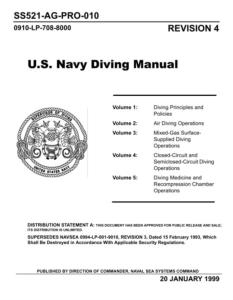


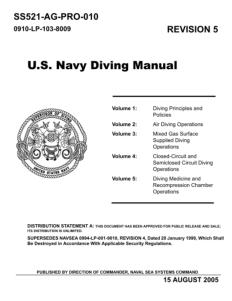

This document was published on the 15th of April 2008.
It provides major reinforcements of the surface-orientated
tables with also a new presentation still used in revision 7.

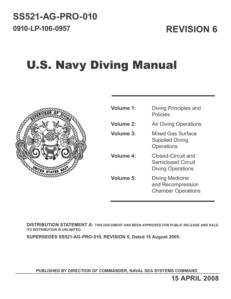

These trimix tables seem experimental and have not been
officially published. The exact date of publication is not
indicated on the document. However, we can consider
that they have been tested between the end of the
seventies and the beginning of the eighties.

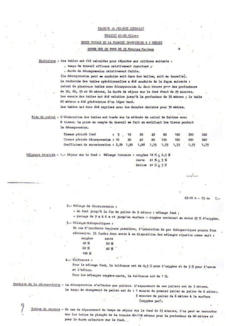

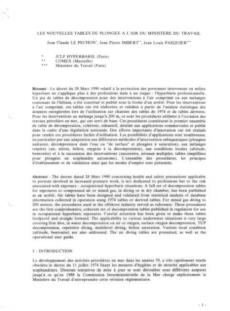


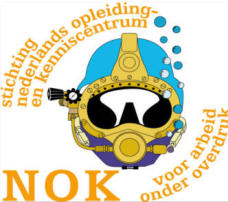

This document has been produced to establish a single
common standard for manned underwater operations in
Norway.
It is continued by the current NORSOK standards that can
be downloaded through the page “Diving & ROV
procedures”. Unfortunately, these standards are no more
available for free.
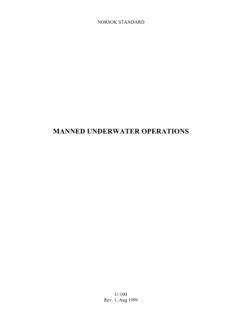

This document contains tables for diving on air or nitrox
and therapeutic recompression procedures for
decompression illness and other ailments requiring
hyperbaric treatment.
It is replaced by revision five that can be downloaded for
free through their website, which link is provided
in“Diving & ROV procedures”.
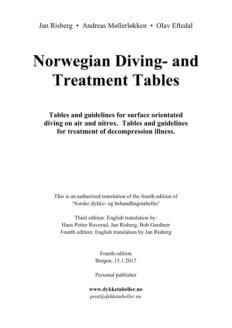


NORMAM-15/DPC procedures propose saturations and
air diving procedures.
The saturation procedures are a development of the
COMEX procedures and are considered among the best
ones for diving operations up to 350 m for which they
have been specifically developed.
These procedures are those selected in the “saturation
diving handbook” Diving & ROV Specialists. They are also
explained in the diving study #5 CCO Ltd, “Implement
NORMAM-15/DPC saturation diving procedures”. Both
documents are available in Documents/Documents
Diving & ROV Specialists.
Note that NORMAM-15 DPC is recommended by the
Diving Medical Advisory Committee (DMAC) for deep
saturation diving operations.
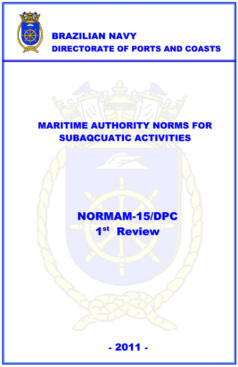

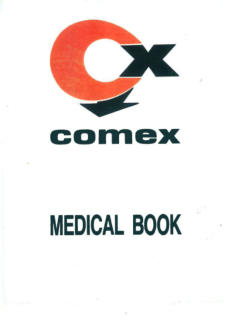

This medical book was considerably in advance
compared to other published manuals at the end of the
seventies.
Note that the majority of these guidelines are still valid. It
is, for example, the case of the medical tables or the
principle of preventive gas reserves, which was adopted
in AODC 14 and then IMCA D 050.


This report was prepared to document the US navy’s
searches for Space Shuttle Columbia debris in the lakes of
East Texas. This report identifies the challenges,
techniques, and science involved in developing the most
effective search solutions.
Reference USN: S0300-B5-RPT-010
Date of publication: September 2003
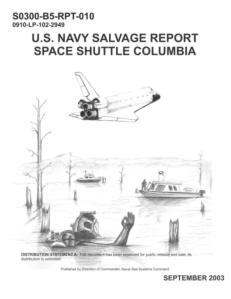

This report documents the efforts of the U.S. Navy to
respond to the Katrina and Rita hurricanes' disasters in
2005 and provides information to responders of future,
similar operations.
Reference USN: S0800-AC-RPT-010
Date of publication: January 2007


This report documents the US Navy operations during 6
months of support to the Coast Guard, Department of
Interior, and Department of Justice of the united states of
America, following the oil spill from the Deep Water
Horizon disaster.
Reference USN: S0800-AC-RPT-010
Date of publication: November 2011
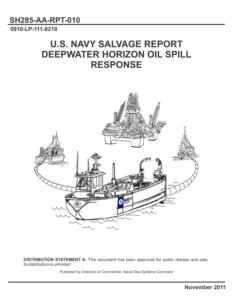


This document updates the previous procedures
published in 2011.
The saturation procedures remain untouched.
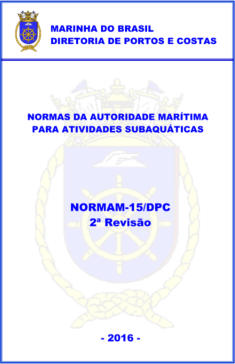

Author: Carmela A. Keeney
This report summarizes underwater cleaning procedures
and devices that are appropriate to use on civil works
structures. It was prepared by the US Naval Civil
Engineering Laboratory, which has conducted extensive
tests and evaluations of underwater cleaning techniques
for waterfront structures.
The cleaning systems evaluated encompassed several
different types that are characteristic of those that are
commercially available. The application, advantages,
disadvantages, and operation of each type of equipment
are discussed.
Note that most recommendations of this document are
still applicable today.

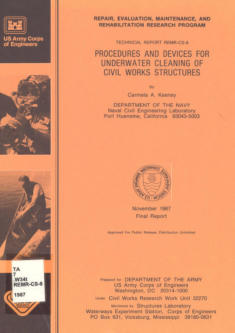

This document is an extract of the US Navy manual 1981
It is revision 1 of the US Navy mixed gas diving manual
(Volume 2) published in 1961.
(Note that the copy is not of very good quality. A better
quality one should be welcome)

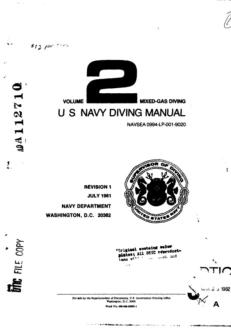

Author: Francis Hermans
This document chronologically relates to the inventions
and practices that have allowed divers to cut underwater
from the beginning of the diving industry.
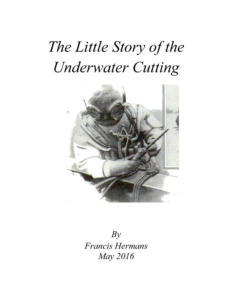

Aurthor: Susan j. Trukken
This paper describes experimentations undertaken by the
US Navy Experimental Diving Unit in April 1984 on the
CLUCAS Underwater Kerie Cable thermal cutting
equipment. The purpose of these tests was to verify US
Navy procedures for setting up, use, and maintenance
and evaluate the hazards and proper procedural
corrections.

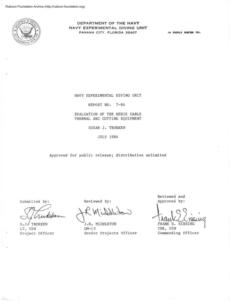

This US Navy guidance describes the types of water
contaminations encountered and how to manage them.
It is superseded by a new version published in 2019 that is
now authorized for public release and is available on this
website (see in “Diving and ROV procedures”. However, it
is helpful to keep this version in mind for comparison
purposes.s with also a new presentation still used in
revision 7.

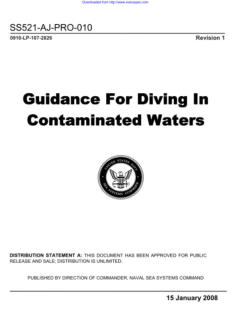

The US Bureau of Reclamation (Reclamation) conducts a
variety of underwater inspection and maintenance
programs that include the use of divers. In order to
ensure employee safety and regulatory compliance,
Reclamation has developed this Diving Safe Practices
Manual (DSPM). This document is superseded by the
version published in 2021.
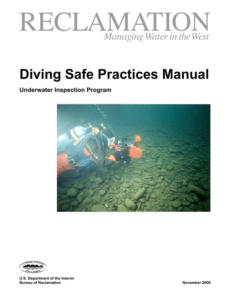

NOAA Diving manual is edited by the USA - National
Oceanic and Atmospheric Administration and the US
Department of Commerce.
This document is the 3rd edition. It considered scuba an
acceptable means of intervention for scientific and
commercial diving. It was also the case in many countries
during this period. This version did not discuss the Unit
Pulmonary Toxic Dose (UPTD) tables.

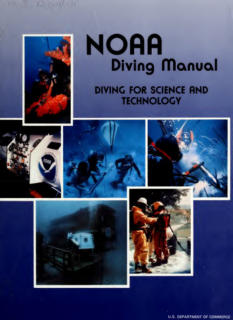

This document is the 4th edition of the NOAA diving
manual.
There are a lot of useful information in this edition that has
been replaced in 2015 and then in 2017 (sixth edition)
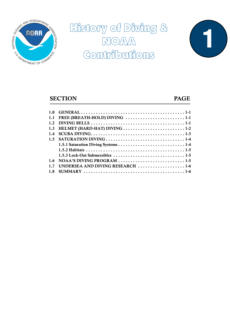

Authors: Kristin Øye Gjerde and Helge Ryggvik
This book, originally published in 2009, presents the
history of diving in support of the oil industry on the
Norwegian continental shelf.
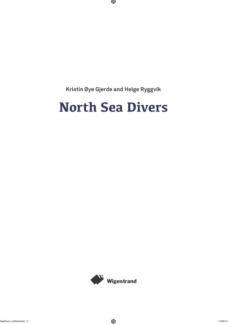

US Navy refrence: NAVSHIPS 0994-001-9010.
This version of the US Navy Diving manual was 1st
published in September 1969 and officially released in
March 1970.
(Document found on Google Books - Not available on the
Navsea website)

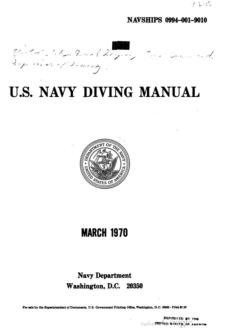


Author: G. C. C. Damant
The "Laurentic" was a 15,000-ton Atlantic liner which,
during the 1st world war, was taken over by the
Admiralty and converted into an armed cruiser. She was
sunk by a German mine in 1917 with five million pounds
in her cargo.
This book relates the recovery of this essential cargo and
is a fantastic testimony to the techniques used during this
period.
Captain Damant was a friend of John Scott Haldane and
was directly involved in the studies of the first
decompression table.

Reference NAVSEA: 0927-LP-001-9110
This version of the US Navy manual did not provide
saturation tables
(It was also found on Google books - Not available on the
Navsea website)

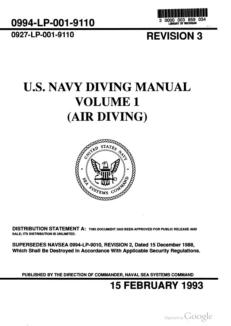


This document is the 1st part of the french decree 2012,
which was the 1st modification of the decree of May
1992 - Note that the decompression table MT 92 has not
been modified.
This document is in French
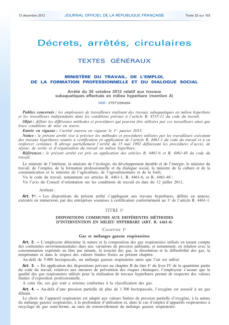


This document is the 2nd part of the French decree 2012,
which was the 1st modification of the decree of May
1992 - Note that the decompression table MT 92 has not
been modified.
This document is in French
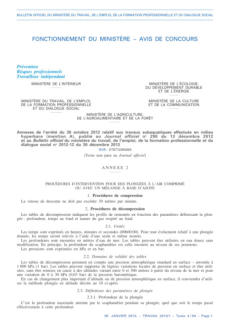

Publisher: Mammoet - Smit international
This document describes the planned operations for the
recovery of the Kursk, a Russian submarine that sank in an
accident on 12 August 2000 with 118 crew members.
The wreck of the submarine was recovered by Mammoet
- Smit international in 2001.
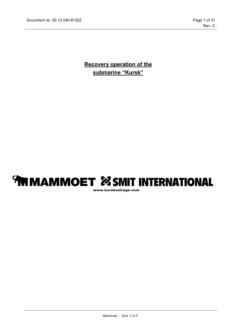


Authors: Godfried Van Moorsel, Floris P. Bennema.
This paper deals with techniques in use before 1940 to
observe marine life or collect specimens by hand in their
natural sublittoral environment. It excludes atmospheric
diving with devices such as submarines and bathysphere.
Also, snorkeling gear or SCUBA (Self Contained
Underwater Breathing Apparatus) is not treated. This is
predominantly a post-WWII development; before 1940, it
was impossible to construct fitting facemasks, and fins
were not yet commercially available.
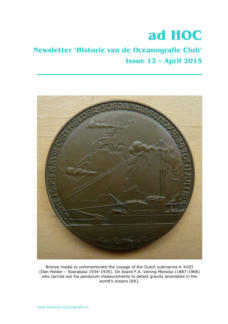

This document, Published in 2004, has been replaced by
revision 2 in 2021. it provides useful information
regarding calculations and relevant practices regarding
the organization of the rigging, the pumping procedures,
and other necessary activities to save or recover a ship. As
for the documents above, the guidelines it provides can
be used for other works than ship salvage.

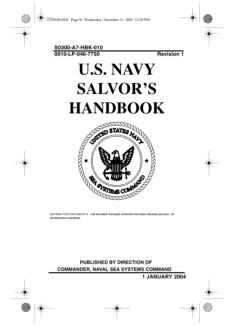

This document provides basic knowledge of naval
architecture and its application to marine salvage. It was
1st published in 1989, and updated in 2006. It has been
replaced by a new edition in 2013. It can be compared
with the latest edition to understand the changes made
by the us Navy.
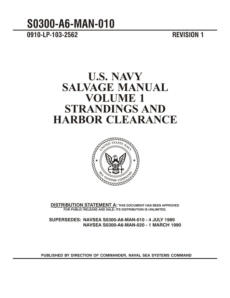

Published by the British Admiralty in 1907
This book is to be considered the 1st diving manual based
on Haldane’s tables. It corresponds to the order made to
John Scott Haldane by the British admiralty for designing
safe decompression procedures, allowing the Royal Navy
divers to dive deeper than previously. Many texts are
extracted from the document “The prevention of
decompression illness”, the scientific paper related to the
experiments that resulted in the 1st decompression table.
In addition, improvements in diving equipment resulting
from the test dives made by Captain Damant and Gunner
Cato are explained.

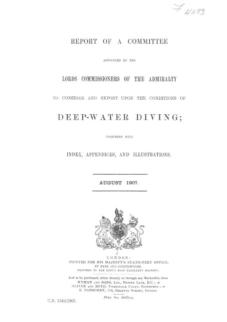

The US Navy Diving Manual 1916 was the 1st document
integrating Haldane’s decompression tables. While they
will be modified later, this edition integrated them without
modifications. As the US Navy manuals of today, this
document was very rich in information.
Copies of this manual are today rare, and we struggled to
find one. This one has been digitalized by "Google Books".

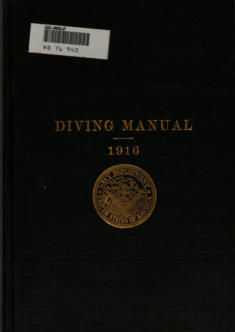
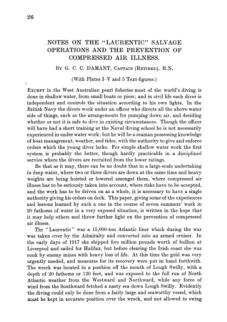

This manual was published to supersede the 1924
manual and covered all aspects of US Navy diving at the
time, including diving on Heliox mixtures. Note that the
air tables were already a modification of those published
by Haldane and the British admiralty in 1907.
Likethe 1916 edition, this book is scarce. This one comes
from the University of Michigan and has been digitalized
by Google Books

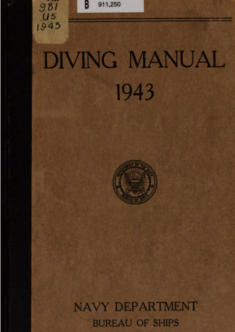

Publisher:
The American academy of underwater sciences
This workshop was held in 1988. Thus, these proceedings
have to be considered with the technology available at
this time. Remember that the computers were far from
having the power and the integration of today’s ones.

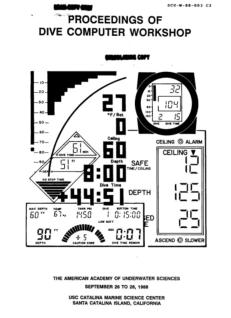

Publisher:
South Pacific Underwater Medicine Society [SPUMS]
This document provides key dates of the history of diving
systems and related scientific discoveries from 4500 BC to
1990.
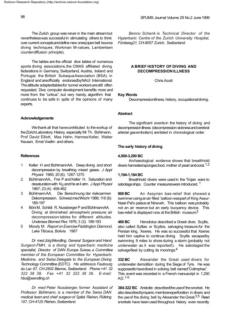

Author: Leslie Collier
This book relates the history of the Lister Institute of
Preventive Medicine, where Haldane’s research on
creating the first decompression table was performed.
Much other scientific research has been done on its
premises later on.
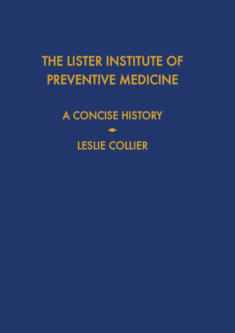

These tables, studied by doctor Fructus, were published
by COMEX (compagnie maritime d'expertises) in 1974
and used until the publication of the Table 1983.

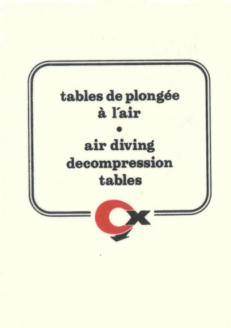

Decompression schedules for air diving at depths of
from 100 to 250 fsw with various times of work on the
bottom were computed by Haldane, Workman, and
Lambertsen techniques, after the method of Buhlmann.
And after the scientific approach of Hills. The resulting
dive table were compared with depth and time diving
schedules used by the U.S. Navy on one hand and those
recommended by the British Royal Naval physiological
laboratory on the other. The comparative evaluations
disclosed that the US Navy
Navy tables have significantly shorter decompression
times and use more shallow decompression stops than
the other tables…

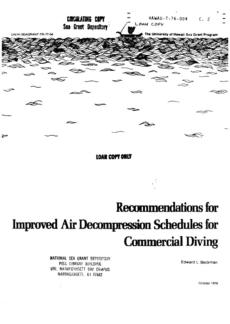

The COMEX (compagnie maritime d'expertises) tables
1987 serve as the foundation for the MT 92 tables and
were introduced to the scientific community at the 37th
Undersea and Hyperbaric Medical Society Workshop for
the validation of decompression tables. The documents
“Safety analysis of French 1974 air decompression tables”,
and “A method for introducing new decompression
procedures”, explain the method used to design it.

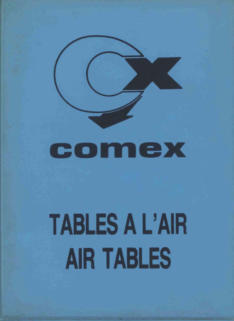

This document, superseded by the 2023 edition,
represents the minimum safety standards for diving under
the auspices of the National Oceanic and Atmospheric
Administration (NOAA) as of the approval date of this
manual.

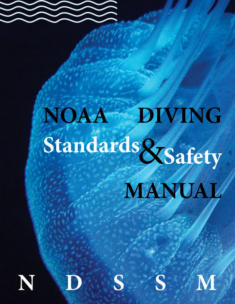



Click on the
octopus to return to
the top of the page

This document, a reproduction of Chapter 36 from the
Manual of the Bureau of Construction & Repair, Navy
Department, was crucial in directing U.S. Navy diving
research and development during its respective period. It
provided comprehensive guidelines on diving
methodologies, equipment operation, and safety
procedures, encompassing diving suits, helmets, and air
supply systems.

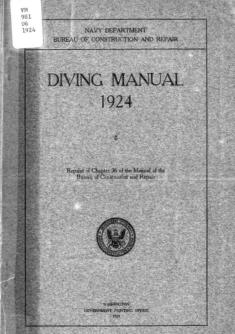

Author: James Royce
This document, released in April 1946, provides a
comprehensive overview of the United States Navy diving
schools during that era.

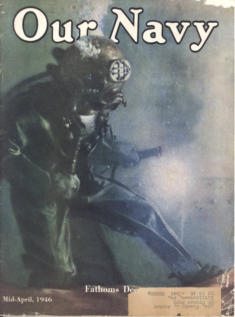

This manual is an improvement on the 1946 edition it
replaced, with the notable addition of heliox diving
procedures.
(Document found on Google Books - Not available on the
Navsea website)

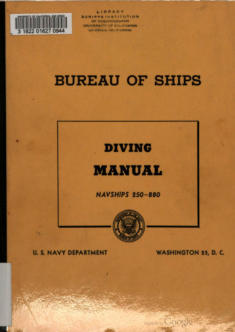

This manual was an improvement over the 1970 edition,
which it superseded. It had three objectives:
•
Assemble and present all available technical information.
•
Provide a means for quickly sharing new developments.
•
Authorize the use of particular practices that assist field
personnel in carrying out their duties.



On the 6th of July, 1988, an explosion and subsequent
fire occurred on the Piper Alpha oil platform, situated in
the North Sea, off the Scottish coast. This catastrophic
event resulted in the loss of 167 lives and the total
demolition of the platform.
Seven days after this calamity, Lord Cullen was assigned
the responsibility of spearheading a comprehensive public
investigation into the incident. This extensive inquiry,
which lasted 180 days, was designed to uncover the
underlying causes and circumstances that led to this
disaster. The recommendations made by Lord Cullen
commission continue to shape safety protocols on a
global scale.


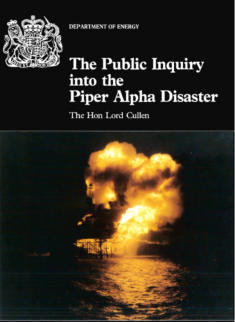

This manual describes procedures for conducting diving
operations as practiced by COMEX offshore during the
1980s, in addition to guidelines for the use of various
underwater tools. Although written during the 1980s, it
can be considered a reference for the conception of a
diving manual.



Authors: Jean Claude Le pechon, Jean Luc Pasquier
In the 1980s, the introduction of shield tunnelling boring
machines (TBM) in France revealed that the existing safety
regulations for compressed air workers, established by the décret
of July 9, 1974, were inadequate for this new technology.
Similarly, the safety rules for commercial divers, set by the décret
of July 11, 1974, were soon found to need improvements due to
the demands of the growing offshore industry. Consequently, a
new French regulation was published on March 21, 1990, with
additional amendments in 1991 and 1992.

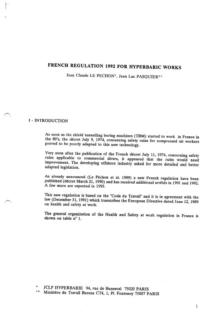

COMEX magazine / Henri Germain Delauze
The intent of this document is to celebrate and highlight
the 50th anniversary of Comex, a company founded by
Henri Germain Delauze. It aims to provide a historical
overview of the company's journey, its technological
innovations, and industrial successes over the past five
decades. The text also emphasizes the founder's
pioneering spirit in the field of underwater exploration
and diving technology.
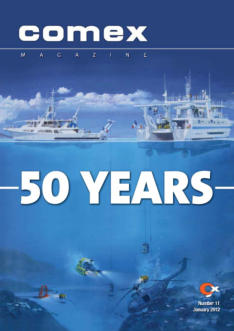

COMEX magazine / Henri Germain Delauze
This document is the French version of the article
described above
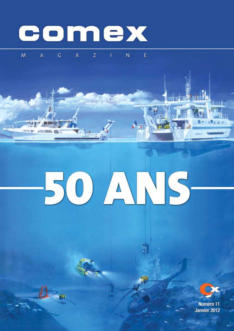

Authors: Robert D. Christ & Robert L. Wernli
This manual provided comprehensive guidelines for
operating and deploying observation-class ROV (Remotely
Operated Vehicle) systems. It aims to educate users on the
basic principles, techniques, and procedures for using
these systems in various underwater tasks. It is designed to
be non-specific to any manufacturer.

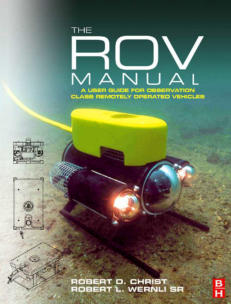

Authors: Chris Bell, Mel Bayliss
and Richard Warburton
The subjects covered in this handbook were wide-ranging
and diverse, making it necessary for the reader to grasp
scientific fundamentals such as electricity, hydraulics, and
photography before reading it. Many books were
available explaining these fundamentals, and the reader
was recommended to familiarize himself with these before
undertaking this course of study..
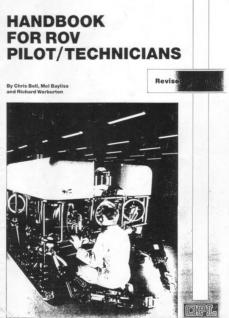

These tables are designed by the Norwegian Diving
and Decompression Tables (NDDT).
This book contains tables for diving on air or nitrox,
as well as therapeutic recompression procedures for
decompression illness and other ailments requiring
hyperbaric treatment, and is an improvement of the
previous edition.
The document can be downloaded by clicking on
the picture of the cover on the side, or through the
official website at the address below:
https://dykketabeller.no/english/index.html

These tables are designed by the Norwegian Diving and
Decompression Tables (NDDT).
This book contains tables for diving on air or nitrox, as well
as therapeutic recompression procedures for
decompression illness and other ailments requiring
hyperbaric treatment, and is an improvement of the
previous edition.
The document can be downloaded by clicking on the
picture of the cover on the side, or through the official
website at the address below:
https://dykketabeller.no/english/index.html

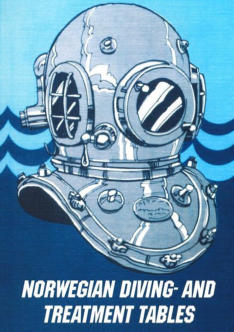



09 - Handbook US Navy Diving Operations - 1974
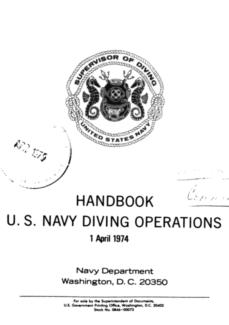

Publisher: International Tunneling and underground
spaces Association, in association with the British society
compressed air working groupAt its meeting in
Vancouver in 2010, International Tunnelling Association
Working Group 5 identified the need for guidance on
the use of high pressure compressed air. WG5 defined
this as “work in compressed air at pressures above
historical statutory limits, which in most countries are
between 3 and 4 bar (gauge), and which involves the
use of breathing mixtures other than compressed natural
air and can involve the use of saturation techniques”.


57 - ITA Working Group 5 ‘Health & Safety in Works’ In Association
with the British Tunnelling Society Compressed Air Working
Group - March 2018
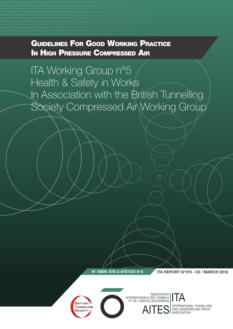


This document, published in January 2020, provides the
ADCI diving guidelines between this date and January
2025, the date when it was superseded by the edition 6.5
currently in force.


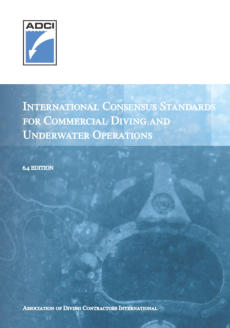

Authors: Vincent T. Covello, and Jeryl Mumpowerz
This paper reviews the history of risk analysis and risk
management, with special emphasis on the neglected
period prior to the 20th century. Its overall objective is to:
Dampen the prevailing tendency to view present-day
concerns about risk in an ahistorical context.
Shed light on the intellectual antecedents of current
thinking about risk.
Clarify how contemporary ideas about risk analysis and
societal risk management differ significantly from those of
the past, and provide a basis for anticipating future
directions in risk analysis and management.


16 - Risk Analysis and Risk Management: An Historical Perspective
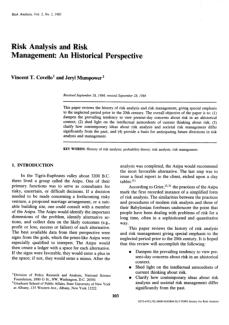
Author: N.C. Flemmings
Scientific Diving involves underwater research conducted
by scientists using breathing apparatus or submersibles.
This paper's Part 2 covers the period from 1975 to 2000,
following a previous publication on 1955 to 1975. By
1975, the Underwater Association's membership had
grown, leading to the publication of Codes of Practice
for diving safety. Various regulations were introduced,
and the UK Natural Environment Research Council
established diving safety committees. This collaboration
resulted in the 1997 Diving at Work Regulations, which
have been regularly updated through 2023.


60 - The Historical Development of Scientific Diving in the UK from
1955 to 2000: Part 2 - 1975 to 2000












